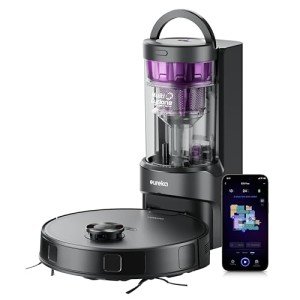10 Things We Hate About Cleaning Robots
Revolutionizing Home Maintenance: The Rise of Cleaning Robots
In an age where technology continues to influence daily life, cleaning robots have actually emerged as a substantial development in the field of domestic cleaning. self cleaning vacuum have actually redefined how households handle cleaning tasks, providing benefit and effectiveness. With their capability to navigate spaces, avoid obstacles, and operate on pre-set schedules, cleaning robots are ending up being important tools for house owners looking to enhance both their time and their living environment.
The Evolution of Cleaning Robots
Cleaning robots have gone through a significant improvement since their creation. What started as basic devices has advanced into sophisticated gadgets geared up with innovative functions. Below is a table highlighting some essential milestones in the development of cleaning robots.
Year
Turning point
Description
1996
First Commercial Robot
The first robotic vacuum, Electrolux's Trilobite, was introduced.
2002
Roomba Launch
iRobot released the Roomba, making robotic vacuum cleaners popular.
2004
Mapping Technology Introduced
iRobot presented smarter navigation abilities, enabling much better cleaning courses.
2012
Mobile phone Integration
The introduction of mobile app control enabled users to control robots from another location.
2020
Advanced Sensors & & AI
Robots started utilizing AI for boosted mapping and object recognition.
Types of Cleaning Robots
As technology has advanced, numerous types of cleaning robots have emerged, each developed to deal with various cleaning requirements. A few of these include:
Robotic Vacuums
- Designed to autonomously vacuum floorings, they often include sensing units to browse around spaces and return to their charging stations.
Robotic Mops
- These robots are geared up with mopping functionality, using water or cleaning options to scrub floorings.
Window Cleaning Robots
- Particularly engineered for window cleaning, these gadgets can climb vertical surfaces using suction or magnetic systems.
Pool Cleaning Robots
- Developed for in-ground swimming pools, these robots gather particles and even scrub the walls of the pool effectively.
Multi-tasking Robots
- Some modern-day cleaning robots integrate vacuuming and mopping abilities, offering versatile cleaning services.
How Cleaning Robots Work
The core performance of cleaning robots is centered around their capability to navigate homes autonomously while executing cleaning jobs. Here's a breakdown of the basic elements that enable them to perform effectively:
Sensors: Most cleaning robots are equipped with sensing units that help them detect obstacles, slopes, and edges, avoiding falls and collisions.
Navigation Technology: Many robots utilize a combination of gyroscopes, accelerometers, and sometimes electronic cameras or LIDAR for navigation. This permits them to map their environment and tidy effectively without missing spots.
Power Sources: Most cleaning robots operate on rechargeable batteries, with many efficient in returning to their charging docks when their power runs low.
Cleaning Mechanisms: Whether through suction for vacuuming or turning brushes for mopping, cleaning robots include various systems customized for effective dirt elimination.
Benefits of Cleaning Robots
The incorporation of cleaning robots in households presents numerous benefits:
Time-Saving: Cleaning robots can operate on their own, allowing house owners to take part in other activities.
Constant Cleaning: With set up cleaning times, these robots guarantee consistent maintenance of the home.
Hard-to-Reach Areas: Cleaning robots can access narrow areas and corners that conventional cleaning tools may have a hard time with.
Reduced Allergens: Regular cleaning helps reduce dust and allergens, contributing to a much healthier living environment.
Limitations of Cleaning Robots
Despite their numerous advantages, cleaning robots also present specific limitations that users ought to consider:
High Initial Cost: While the price of cleaning robots has decreased with time, some sophisticated designs can be reasonably pricey.
Irregular Performance: Not all robots perform similarly; some may battle with specific surfaces or dirt types, leading to unacceptable results.
Limited Capacity: Many robotic vacuums have smaller sized dustbin capabilities, requiring more regular emptying than traditional vacuum cleaners.
Frequently Asked Questions about Cleaning Robots
Q: Are cleaning robots worth the investment?A: Cleaning robots can be
a worthwhile investment for those looking for time-saving services. They can substantially relieve the cleaning concern, especially for busy families. Q: Can cleaning robots be programmed?A: Yes, lots of cleaning robots come with programmable schedules and modes, allowing users to set particular cleaning times and areas. self cleaning vacuum : How do I keep my cleaning robot?A: Regular upkeep includes cleaning the brushes, clearing the dustbin, and occasionally examining for software application updates. Q: Are cleaning robots efficient on all surfaces?A: Most robotic vacuums work on difficult floors and low-pile carpets. However, efficiency might
differ on thick carpets or certain kinds of rugs. Q: Do cleaning robots work well under furniture?A: Cleaning robots are designed to fit under a lot of furnishings; however, the effectiveness can depend on the height of the furnishings.
**Cleaning robots represent a development in the realm of
domestic tasks, providing a blend of technology, convenience, and efficiency. While they are not a total replacement for conventional
cleaning techniques, they considerably enhance housekeeping capabilities. As developments continue, future models of these gadgets are anticipated to become much more intelligent, efficient, and user-friendly, additional incorporating into the smart homes of tomorrow. The contemporary property owner therefore faces an interesting future where cleaning robots could take much of the drudgery out of home maintenance, enabling a cleaner home with minimal effort.  **
**